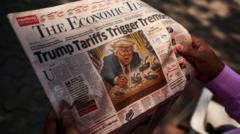Despite government optimism, consumer spending in China remains weak as tariffs impact economic growth and consumer confidence wanes.
China's Economy Faces Challenges Amid Trade War and Domestic Consumption Struggles

China's Economy Faces Challenges Amid Trade War and Domestic Consumption Struggles
As U.S.-China tensions escalate, Beijing's plans to boost domestic consumption may not suffice.
As the U.S. and China entered into a deepening trade war, one of Beijing’s bustling shopping districts reflected the dichotomy of the situation. High-end shops in areas like Guangzhou continued to draw crowds—a scene that the Chinese government views as essential while facing the repercussions of significant U.S. tariffs, which currently stand at a staggering 125 percent on numerous imported goods. The Chinese government’s resolve remains firm, illustrating its determination not to concede ground in the conflict with the U.S.
Simultaneously, China is grappling with its own economic hurdles. The state media has projected that, in light of diminishing trade prospects with the United States, domestic consumption must become the primary driver of economic growth for the nation. A recent article in the People's Daily emphasized this adjustment, stating the ambition to leverage the "super-large market" that China possesses. However, bolstering domestic consumption is easier envisioned than actualized.
Prior to the trade war, China had already been witnessing lackluster domestic consumption. The recovery from the pandemic has been tepid, leading to factory shutdowns and notably high youth unemployment. The sharp decline in home prices—crucial to the financial stability of many middle-class families—worsens the financial landscape. Although shopping districts like Taikoo Li appear vibrant, actual consumer behavior tells a different story. Many Chinese citizens are opting for bargains or simply browsing without making purchases.
The case of Qu Nan, a 38-year-old construction company founder seen sipping coffee without an actual drink in hand, provides insight into the evolving consumer psyche. It reflects a greater hesitation among consumers who, despite being in affluent areas, are cautious in spending due to broader economic uncertainties and dwindling disposable incomes.
While the Chinese government remains optimistic in its quest to recalibrate the economy and foster a more robust domestic market, growing evidence suggests that overcoming established economic challenges and heightened consumer caution will require more than just a reiteration of policies; it will demand substantial and innovative efforts to restore consumer confidence and spending in a volatile landscape marked by escalating external pressures.
Simultaneously, China is grappling with its own economic hurdles. The state media has projected that, in light of diminishing trade prospects with the United States, domestic consumption must become the primary driver of economic growth for the nation. A recent article in the People's Daily emphasized this adjustment, stating the ambition to leverage the "super-large market" that China possesses. However, bolstering domestic consumption is easier envisioned than actualized.
Prior to the trade war, China had already been witnessing lackluster domestic consumption. The recovery from the pandemic has been tepid, leading to factory shutdowns and notably high youth unemployment. The sharp decline in home prices—crucial to the financial stability of many middle-class families—worsens the financial landscape. Although shopping districts like Taikoo Li appear vibrant, actual consumer behavior tells a different story. Many Chinese citizens are opting for bargains or simply browsing without making purchases.
The case of Qu Nan, a 38-year-old construction company founder seen sipping coffee without an actual drink in hand, provides insight into the evolving consumer psyche. It reflects a greater hesitation among consumers who, despite being in affluent areas, are cautious in spending due to broader economic uncertainties and dwindling disposable incomes.
While the Chinese government remains optimistic in its quest to recalibrate the economy and foster a more robust domestic market, growing evidence suggests that overcoming established economic challenges and heightened consumer caution will require more than just a reiteration of policies; it will demand substantial and innovative efforts to restore consumer confidence and spending in a volatile landscape marked by escalating external pressures.























